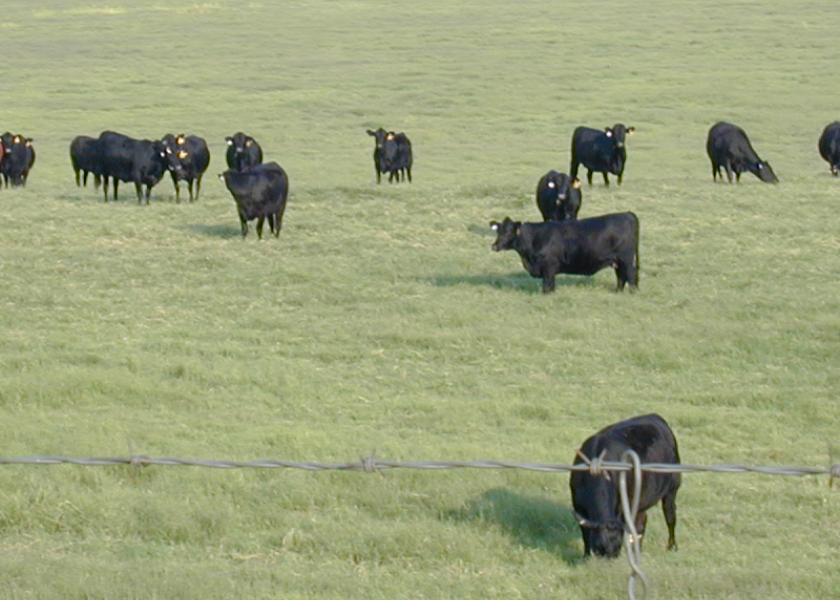Managing Cow Body Condition is Critical for Profitability

In the cow-calf production system, reproductive efficiency is the No. 1 driver of profitability.
“That’s how this business works,” says James Rogers, North Dakota State University Extension forage crops production specialist. “We market the offspring from our herds. No offspring, no profit.”
Rogers references a measure of reproductive performance used in the swine industry called “non-productive days,” or days that a gilt or sow is neither gestating or lactating. Each non-productive day comes at a cost and serves as a benchmark measure of reproductive and economic performance in a swine herd.
“A sow has a huge reproductive advantage over a beef cow, as a sow will have two or slightly over two litters per year with multiple piglets,” Rogers says. “A beef cow should have zero non-productive days. Each day of the year, she should be lactating, gestating or preparing to rebreed. A beef cow gets one day a year to calve and only 80 days from calving to rebreed in order to stay within a 365-day calving interval. Cows with longer calving intervals cost more to maintain and produce less weaned calf than earlier calving cows.”
Rogers adds that a 100% pregnancy and calving rate is not realistic, but ranchers should expect an open rate of around 8% in mature cows and 12% in heifers. Numbers higher than benchmark averages indicate that there may be an underlying cause. Reports across North Dakota indicate a wide range in open rates from the benchmark averages to as high as 30%.
According to Rogers, the single most important factor in keeping a cow at zero non-productive days is body condition, the amount of fat cover a cow is carrying through the various stages of the production cycle. Body condition has a direct impact on calving interval, conception rate and percentage of open cows. To access body condition, ranchers and researchers use a scoring scale of 1 (emaciated) to 9 (very obese).
Research has shown that cows that calve at a body condition score of 5 to 6 will return to estrus in 50 to 60 days. A cow calving at a body condition score of 4 will take 70 days. With only 80 days available from calving to rebreeding to stay on a 365-day calving cycle, this does not allow much time. For spring calving herds, Rogers recommends ranchers take body condition scores now while there is still time to economically add condition prior to calving if needed.
“Realize that it takes around 100 pounds of weight gain to change 1 unit on the body condition scale,” says Karl Hoppe, NDSU Extension livestock systems specialist. “If a cow requires such a gain, consider whether you have quality feed supplies on hand to accomplish it. A forage test can help you know what you are working with. Forage tests cost about $20 per sample. An open cow could cost you about $1,200 in lost calf revenue plus cow maintenance costs for a year. The return on investment for a forage test is hard to beat.”
It’s slow progress to change the body condition score of a cow. When balancing a ration for a one pound per day gain, it will take three months to increase one body condition score, Hoppe says. Extreme cold weather can decrease one body condition score quickly if the ration is not changed to include more energy. Prolonged winters like 2022-2023 can reduce body condition score without the owner recognizing the change.
Describing how a body condition score of 5 to 6 should look can be difficult because one person’s 5 is another’s 6. Online images of cows in the various body condition scores can be a guide, and NDSU Extension livestock specialists and county agents are available to help determine body condition score in cowherds. Consistency in scoring is important when evaluating the herd.
Rogers uses an analogy to help others to visualize the body condition scale based on the condition of a cat.
- If the cat is round, with no defined shape or waistline, and you can’t feel the ribs, then this cat probably has a body condition score of 7 to 9 (on the fat side).
- If you can see the cat’s waist and feel its ribs, but it has a covering of fat down the back with some cover over the ribcage, it is a 5 to 6 (considered ideal).
- If ribs and hip bones are clearly visible on your cat, and there is a lack of cover down the back and ribs, this cat is a 1-4 and needs to gain weight. The same is true for cows.
“When open cow numbers are higher than average, many ranchers assume something happened during the breeding season, and it probably did,” Rogers says. “Cows may not have been cycling or cycled late. The cause may have occurred before the breeding season with less than adequate cow body condition in late gestation and calving. Access cowherd body condition now to minimize open cows in the fall.”
In addition to body condition score, NDSU Extension specialists recommend ranchers consider other parts of the production system this winter. Some questions to consider are:
- Is the stocking rate for the cowherd adequate for the amount of range and pasture biomass produced?
- Do the genetics of the cowherd match ranch resources?
- Are production records in place to track calving interval?
- What is the marketing plan for open cows?
Giving these matters attention now keeps the cowherd in optimal condition year-round, Rogers says.







